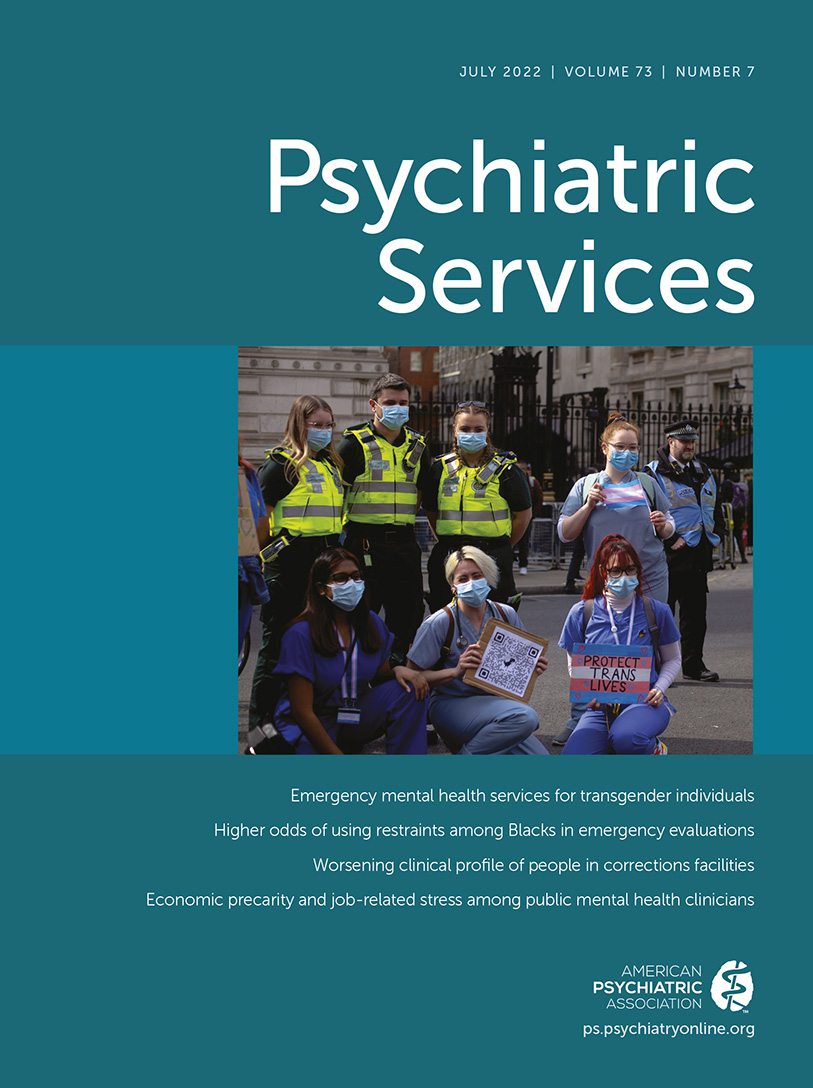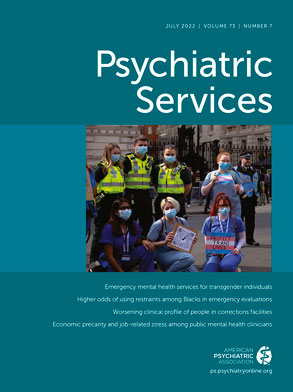The growing global burden of mental illness is arguably one of the world’s most “wicked” problems (
1,
2). Because of the lack of resources dedicated to mental health, from policy development to service delivery, and the inefficiencies and inequities in resource distribution, people with serious mental illness in low- and middle-income countries (LMICs) have limited access to evidence-based treatments and psychosocial rehabilitation. In this context, they face high rates of unemployment because of inequity in the hiring process and job loss due to social exclusion and a lack of work schedule accommodation. The number of visits to community-based mental health services in LMICs is 20–50 times lower than in high-income countries (HICs) (
3). The proportion of people with serious mental illness receiving social supports, such as disability support payments, income and housing support, and employment services, is also significantly lower in LMICs compared with HICs (
3).
In many LMICs, resource scarcity and limited access to mental health care occur alongside high levels of stigma and discrimination and amid the interdependent social determinants of poor health, including poverty, conflict, displacement, and gender-based violence (
4,
5). The limitations of individual-focused, biomedical, and institutional models of mental health care have been increasingly recognized, as has the need to emphasize the role of social and cultural factors in understanding and addressing mental illness (
6).
In response, the Lancet Commission on Global Mental Health and Sustainable Development (
7) has reframed its agenda and shifted focus from reducing the treatment gap to reducing the global burden of mental and substance use disorders by concurrently addressing prevention and gaps in quality and by extending the scope of treatment to include social care. The global mental health community has been called on to implement and scale up innovations that involve task sharing of psychosocial interventions with nonspecialized workers as part of the foundation of the mental health care system and to implement community-based interventions to enhance the demand for care (
7).
A critical aspect in heeding this call is the need to disrupt the viewpoint that people with mental illnesses are a problem. Rather, they are citizens, workers, and family members who offer many social contributions. An intervention paradigm aligned with this viewpoint is consistent with approaches to asset-based community development (
8) and social innovation (
9) that consider the social and economic contexts of local communities: their ways of operating, priorities, power structures, and resource distribution and how these beliefs, routines, resources, and authority structures can be transformed. Such a paradigm would not ignore the importance of evidence-based treatments but would recognize that even in the presence of serious mental illness, the strengths of individuals with these illnesses and their families can be activated to support collective self-help and community action.
Evidence from both HICs and LMICs, integrated with theoretical foundations, has provided a guiding framework for this intervention paradigm. This framework includes approaches to health literacy (
10) and evidence-based wellness management (
11) focused on promoting personal self-care and well-being through access to basic relevant health-related information; peer networking, empowerment education (including on basic human rights), and leadership development that provide an organized forum for sharing information and experiences, foster better understanding of the causes of social problems, encourage problem solving, and provide an organized structure to effect community change (
12); rapid access to employment in the local community economy to utilize the social and financial benefits of paid work and advance the image of people with serious mental illness as contributing members of their communities (
13); social enterprises that use market-based strategies not only to improve employment opportunities but also to create a context to demonstrate the potential contributions of people with mental illnesses (
14); and development of local partnerships to advance mutual goals for personal and community prosperity and well-being (
12). Through their focus on promoting agency, community collaborations, economic status, and social inclusion, these practices have the potential to enhance personal well-being, reduce the burden and distress experienced by families, organize effective advocacy initiatives, reduce stigma and discrimination, and improve access to medications and other treatments.
Change in Action
A recent initiative in Kenya (
15) demonstrates how an intervention that integrated all of these practices built on the strengths of the community and served as a “disruptive innovation”—that is, a simpler solution with greater affordability and accessibility compared with conventional approaches that enabled uptake of mental health care by a previously ignored population or excluded community (
16). Using codesign and participatory methods, CREATE Kenya (Community Recovery Achieved Through Entrepreneurism) focused on an approach that integrated two major initiatives: a social enterprise (a community business hiring people with serious mental illnesses) and a context-sensitive and peer-facilitated evidence-based psychosocial rehabilitation toolkit, which offered individuals with serious mental illness and their families an opportunity to build knowledge about mental illness and self-management strategies. The social enterprise created the context for collaborations with local business organizations and government agencies that shared the goal of advancing the economic vitality of the community. The initiative also engaged hospital service providers, family members, disability advocates, and peers in building connections with mental health service users, learning about the practical elements of the initiative, and considering how innovations might be implemented more broadly. CREATE built on similar approaches previously developed and carried out in low-resource settings (
17) by strengthening the peer support model aspect of such approaches, repositioning the primary identity of service users as something other than “mentally ill,” and integrating the psychosocial rehabilitation support directly into the business setting and employee role.
The CREATE process was dynamic and had unplanned events and obstacles. Like many businesses, the initial social enterprise did not survive financially, and labor disputes in the mental health system disrupted the momentum of collaborations with health care professionals. However, through their experiences working with the business, the initial seven individuals with mental illness who were hired gained business acumen and knowledge of relevant social structures, and these acquired assets were subsequently invested in new business undertakings, both individual and collective. These individuals also began speaking about mental illness proudly and openly in the community, engaging with local politicians, and asserting a presence at local community events. The initiative sparked the creation of a more formal peer network and a registered local self-help group. Qualitative evaluation found that individual-level changes included dramatic alterations in behavior, such that participants moved from life patterns characterized by inertia, alienation, and problematic social behaviors to patterns of productivity, self-care, and positive social interactions. Evaluation of the initiative also indicated that increases in daily productivity by family members with serious mental illness led to improvement in relationships within the family and reduced sense of burden among family members (
15).
Conclusions
Innovations that seek to address complex and seemingly intractable problems must often target institutions and the ingrained thinking and processes that go with them in order to create new and disruptive paradigms in the process of social change (
18,
19). To effect change in unpredictable, nonlinear and context-sensitive scenarios, a systems change approach that integrates a broad and diverse group of stakeholders is needed (
18).
The CREATE team recognized the futility of approaching mental health inequities in a LMIC as a problem of mental illness that could be addressed by conventional, Western-driven biomedical models. Instead, the issue was viewed as a result of resource and power imbalance and was addressed through a multimodal, collaborative approach that sought to disrupt existing models and empower people in the community with serious mental illness who had become socially marginalized and essentially voiceless. This partnership not only leveraged available funding, expertise, and commitment, but, more importantly, it also used social enterprise, empowerment education, and health literacy to shift the roles and self-perceptions of people with serious mental illness and their families as well as the perspectives of individuals in positions of power within Kenyan institutions. Such a shift helped to reduce stigma and create opportunities for people with mental illness in their communities. The result was an evolutionary process of change that was unpredictable in course, responsive to emerging opportunity, and increasingly driven by people with mental illness.
Multiple barriers to change initiatives, many of them attitudinal, exist in Kenya and other LMICs with respect to mental illness (
20). People with serious mental illness generally maintain a low social status, and most are reluctant or unable to serve as their own advocates. Social enterprises are often perceived as charities, rather than legitimate businesses, and their employees are expected to be paid lower than market wages. People with serious mental illness in Kenya and other LMICs have limited access to information about their health conditions and how to self-advocate within the health system and local communities (
20). Well-meaning service providers are constrained in their efforts to advance novel practices both within and beyond the institutions where they work, with finances being a major barrier.
Furthermore, the local environment in some LMICs may include a host of other subtle forces that work against such community development initiatives. Notably, these include local tribalism and rejection of official channels, skepticism regarding the commitment of nongovernmental organizations and researchers from wealthy nations and their ability to honor local priorities and create sustainable change, a culture of corruption and bribery related to securing needed supports, and the typically slow response to official and nonofficial requests for information. With CREATE, engagement of local mental health experts and the hiring of a local community developer as the project manager were critical to ensuring sensitivity to the local culture and to navigating challenging, unspoken onsite barriers. Additional research is needed to support the system-level change model implemented in this setting, to create replicable change models for similarly complex contexts, and to ensure sustainability of the movement.
Lessons learned through this endeavor can be similarly applied to HICs, where people with serious mental illness are also often marginalized. Although social enterprise–driven approaches have been used in these HICs, costly individualized and provider-driven models remain the dominant strategy. There is a need for less medicalized and more integrative approaches to mental health interventions that combat stigma, build partnerships, and restore power to vulnerable individuals. Disruptive approaches to systems change are the emerging solutions to the long-established and perplexing inequities on the road to creating more equitable, sustainable, and thriving societies.

